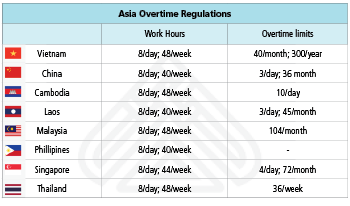When companies turn to Vietnam to establish their manufacturing operations, it is important to consider the laws on regular wages and overtime polices that will be applicable to the workforce and style of a given operation. One of the benefits of Vietnam is that wages are low compared to the rest of the region, particularly China.
Overtime and night work policies in the socialist republic are essentially the same as those in China. The Vietnamese government enumerates all of these regulations in the new Labor Law of 2019 (Law No. 45/2019/QH14) and Decree 145/2020/ND-CP. Understanding how these laws and guidance shape costs is of utmost importance for investors seeking to maximize Vietnam’s potential as a low-cost destination for manufacturing.
Triggering Overtime
The first consideration an employer must make is to ensure a thorough understanding of when overtime is applied. Understanding this threshold allows for the optimization of production targets to customers’ cost and time constraints.
Pursuant to the regulations mentioned above, regular working hours cannot exceed eight hours a day, 48 hours a week. For employees working in heavy lifting or hazardous conditions, the law stipulates employers are responsible for limiting their work due to exposure to dangerous substances or chemicals as per the national technical regulations and relevant laws. If a worker exceeds these limits, overtime compensation will be applied.
In addition to working beyond a set threshold of hours, overtime compensation may be triggered and influenced by the time and date that employees are working. Key triggers of overtime beyond hours worked include weekends, public holidays, and night hours—defined as between 22:00 and 06:00.
Overtime Compensation
If a company triggers overtime, they will be required to compensate employees beyond the wages that are outlined in their contract (see Table 1). This is applicable to all employees regardless of the wages that are offered. Table 2 shows the percentages (more than the standard) that are applied if certain work-related thresholds are crossed.
Table 1—Overtime Calculation
.png?sfvrsn=26e461e7_0)
Table 2—Overtime Compensation Rates
.png?sfvrsn=36e461e7_0)
Note: There are limitations on the number of overtime hours an employee is allowed to work. As per the new labor code, overtime hours cannot exceed 40 hours per month from the previous 30. The new labor code also supplements cases where employers are permitted to organize overtime work for up to 300 hours per year, including manufacturing and exporting of electric and electronic products, and work requiring high technical qualifications.
In cases where an employee works extra hours at night, they are paid extra in accordance with the applicable regulations. Further, employees who are given time off for working extra hours will need to be paid the difference between their wages during normal working hours and overtime work. Finally, employees who work night shifts must be paid at least 30% higher than normal.
Pregnant Women, Women With Babies, Minor Employees
Women who are in their seventh month of pregnancy and women with babies under 12 months old are prohibited from working overtime, working at night, or taking long-distance business trips. Further, pregnant women performing heavy lifting work, must either be transferred to lighter work or decrease daily work time by an hour, while maintaining the same total pay.
The Vietnam Labor Code also establishes strict regulations for minor employees, which are workers under the age of 18. Minor employees are prohibited from working in dangerous conditions or with potential exposure to toxic substances. The Ministry of Labor, Invalids and Social Affairs (MoLISA) also establishes a limit on which industries and what kind of work minors can undertake.
Minor employees between the ages of 15 and 18 can work a maximum of eight hours a day and 40 hours a week. They are only permitted to do overtime and night work in certain industries, as specified by the Ministry. For workers under the age of 15, regulations establish maximum work hours at four hours a day and 20 a week, with no overtime or night work permitted. Working hours for those under 13 years of age is further reduced to one hour per day.
Vietnam vs. China
The Labour Law of China establishes similar regulations for their employees. Employees working overtime must be paid at a rate of at least 150%; for work done during rest day/weekend, 200%; for work during a holiday, 300%. China has stricter rules regarding the amount of overtime work than Vietnam. Chinese workers are limited to only an hour of overtime work per day and three hours if it is a special circumstance. The monthly limit is 36 hours (see Table 3).
Table 3—Overtime Regulations Across Asia

As Chinese wages continue to rise and the economy transitions towards a more efficiency-based structure of production, Vietnam and the wider ASEAN region has increasingly been tapped as the next factory of the world. Those looking to explore opportunities in ASEAN’s growing manufacturing base must be aware of the nuances found within the region and tailor their operations accordingly.
This article was first published by Vietnam Briefing, which is produced by Dezan Shira & Associates. The firm assists foreign investors throughout Asia from offices across the world, including in China, Hong Kong, Vietnam, Singapore, India, and Russia. Readers may write to [email protected] for more support.